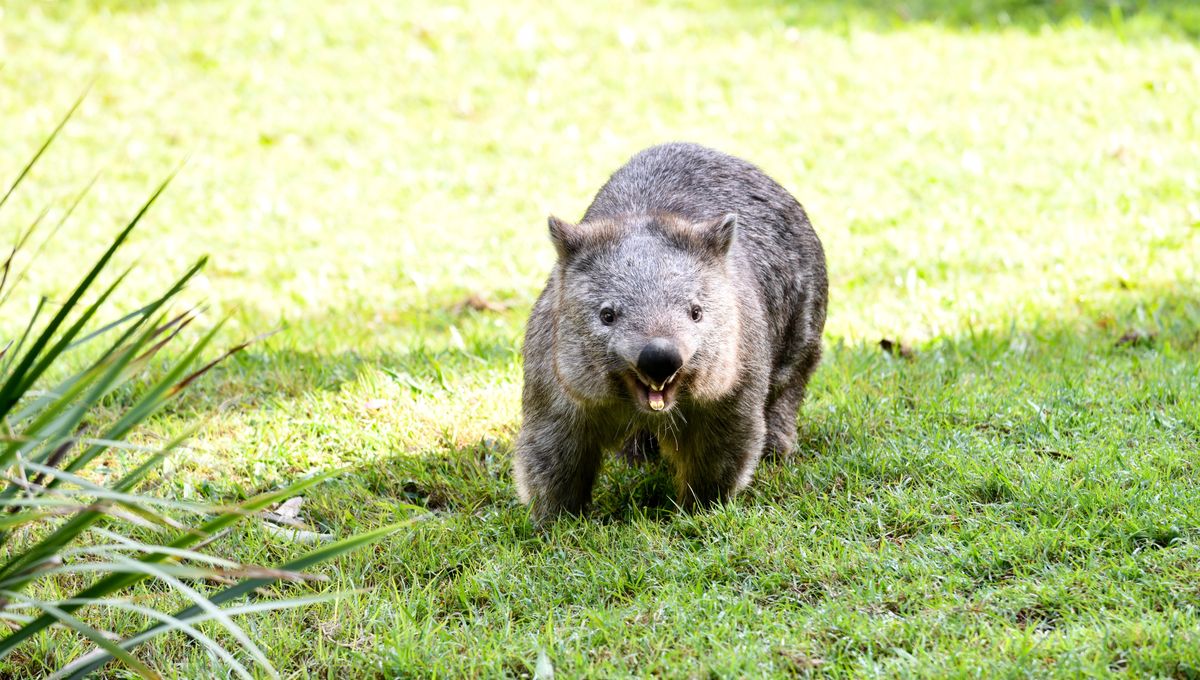
If you were assigning animals to sporting contests based on looks alone, you wouldn’t send a wombat to track and field. With short legs and a mighty butt, wrestling might be a more obvious choice, or perhaps weightlifting. Yet wombats can produce a surprising turn of speed. Some even propose carrots strategically placed at the finish line could have led to a very surprising outcome if someone had smuggled a wombat into the stadium at the Sydney Olympics just before the 100 meters was run.
Carers for orphaned wombats are familiar with the “zoomies” where they make short, enthusiastic dashes incongruent with their very low metabolic speed, before turning 180° and running back the way they came. In the wild, startled wombats will head for their burrows at high speed, but as far as we know, there is no record of an athlete trying to beat them.
Early this year, Museums Victoria received an inquiry that read: “I’ve seen the often quoted speed of 40km/h associated with the wombat. I believe this to be a modern myth and have not found a single primary source evidencing this… Can you please help me either find a source or paper where a wombat’s speed is actually measured?” It’s not just a folktale either. The claimed speed appears in multiple textbooks.
The Museum’s inquiries of leading wombat researchers met with initial skepticism regarding the claim. A paper published around the same time included the claim in their “wombat myths” category. The ABC then took up the question and cast a wider net, but initially got the same result – scientists agreed that wombats were fast, but not that fast.
They could beat Usain Bolt over a short distance, but not 100 meters.
Dr David Taggart
That was until The University of Adelaide’s Dr David Taggart, who had been out in the field, returned the ABC’s messages. Taggart said he had clocked wombats in the field at 40 kilometers per hour (24.9 miles per hour). If sustained, this would allow a wombat to run 100 meters (328 feet) in 9 seconds, smashing the (human) world record of 9.58 seconds. Since wombats take almost no time to hit top speed, the only question in a human versus wombat race would be whether the wombat could maintain its pace to the finish line.
Returning to the source, Taggart told Museums Victoria, “They can run at 40km/h. But they can’t sustain it— it’s a short, fast burst of about 50 metres [164 feet]. If they stay above ground a couple of hundred metres they’ll just stop.” However, he also acknowledged he hadn’t published this astonishing fact anywhere.
IFLScience needed to know more, and contacted Taggart ourselves. “I’ve been working on wombats for 30 years,” he told us. “We’ve chased about 12,000 and caught 2,600.”
“We routinely drive around in a ute (Australian for pickup truck). The only way to catch a wombat is by surprise. We have two runners with nets, who jump off the back and race after it.”
Timing the wombats’ speed was not the point of the exercise – catching them to investigate their ecology and study assisted breeding techniques was. Nevertheless, the team took notice of the speedometer when ute and wombat were moving together, and say speeds of 40 kilometers per hour (24.9 miles per hour) were standard.
Most of the time the wombat will be too close to its burrow to catch it. Guarding the hole doesn’t work, since they often have several entrances. However, in the breeding season wombats go further afield in search of love. In this case the team can often pursue them until they stop for a breather.
Taggart doesn’t think that even in a country willing to do almost anything for Olympic success Australia should be looking at conferring honorary human status on wombats. “They could beat Usain Bolt over a short distance, but not 100 meters,” he told IFLScience, while also noting wombats are reaching that speed on rough ground and “can turn on a 2 cent piece” (or would be able to if Australia hadn’t abolished them decades ago).
Almost all Taggart’s work has been on southern hairy-nosed wombats. The northern hairy-nosed is far too endangered to risk bothering in this way. He told Museums Victoria less was known about the common (also known as the bare-nosed) wombat’s speed as they “live in more vegetated areas so […] they’ll disappear into the scrub [before top speed can be measured].” However, since the bare-nosed wombats grow to be larger than their southern hairy-nosed cousins, there is a fair chance they can cover more territory as well.
A bare-nosed wombat keeping up with a car.
Like humans, any animal species will contain a variation of athletic aptitude. There’s a fair chance some Usain Wombolt that could leave its counterparts in the dust has evaded Taggart’s attention.
Wombats’ surprising speed has sometimes been attributed to the need to get away from dingoes, but Taggart doubts “one dingo could hurt [an adult]. It would have to be a pack… but dingoes do hunt in packs.” The speed has also been attributed to a legacy of needing to outrun thylacines, but it’s also unlikely speed would have been the best defense against an ambush predator.
Taggart noted that Indigenous Australians hunted wombats, adding, “They taste like lamb.” We refrained from asking him how he knows this. Perhaps evolving to run fast was easier than to taste bad.
Taggart didn’t publish his speed observations, considering it unimportant, but in response to the interest generated by the articles one of his students suggested acquiring a speed camera. “We’re thinking about it,” Taggart told IFLScience. Crowdfunding would probably raise the money easily, but: “We’d have to get it through an ethics committee,” he told IFLScience.
Source Link: Textbooks Say A Wombat Can Outrun An Olympic Sprinter. Is It True?